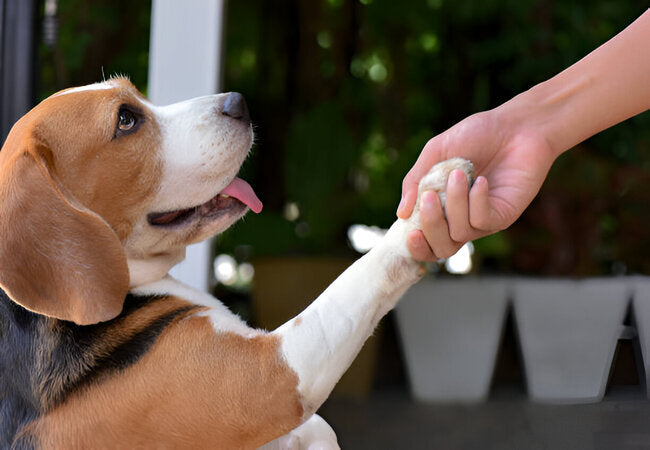Dog Introduction Guide: 2025 Vet-Approved Steps for Positive Meetings 🐕🐕

In this article
🐶 How to Introduce Dogs the Right Way in 2025: Step‑by‑Step Guide to Calm, Positive Meetings
By Dr. Duncan Houston BVSc
🤔 Why Proper Introductions Matter
Gradual, positive introductions help dogs build associations based on trust, not fear or territorial stress. Rushed meet‑ups may spark conflicts that strain long-term harmony.
🧰 Step 1: Prepare the Right Gear & Environment
- ✔️ Use secure harnesses or martingale collars and 6‑ft leashes (no retractables) to maintain gentle control.
- ✔️ Choose a large, neutral location—like a park neither dog has marked—keeping them ~30 ft apart .
- ✔️ Have plenty of high-value treats ready for rewarding calm focus.
🐾 Step 2: Parallel Walks — Side‑by‑Side Calm
With handlers walking in sync ~30 ft apart, let the dogs sense each other's presence without pressure. Reward them for looking at you—this builds positive focus .
Once relaxed, swap places so each dog can sniff the other's path—learning through scent.
👀 Step 3: Watch Body Language Closely
Learn the signals:
- ✔️ Loose posture, wagging tail = acceptance
- ⚠️ Stiff stance, hackles raised, staring, growling = stress
If signs of discomfort appear, increase distance or pause to allow relaxation.
🤝 Step 4: First Sniff and Meet
Once both dogs remain calm side by side, gently decrease distance. If comfortable, allow a quick sniff greeting (<30 seconds). Praise for calmness, then continue walking without direct interaction .
🏡 Step 5: Transition Indoors Safely
- Remove toys, food bowls, and beds to avoid resource competition.
- Keep both dogs leashed while entering together, then allow supervised off‑leash time in neutral spaces.
- Maintain separate feedings, toys, beds—only gradually share resources once both dogs adjust .
💡 Step 6: Supervise & Enforce Calm Interactions
During early cohabitation:
- ✔️ Supervise all interactions, gently intervene if over-stimulation or guarding occurs
- ✔️ Provide structured breaks—give each dog “one-on-one” attention to avoid jealousy
- ✔️ Reinforce calm behavior and tolerance continuously
🐕 Resident Dog Corrections
If introducing a puppy, expect gentle correction (“snap”). This is healthy social teaching—only be concerned if it escalates to severe aggression .
🔁 Step 7: Ongoing Socialization Settings
Continue bonding across environments:
- ✔️ Visit new parks, go for rides, expose them to everyday life stimuli
- ✔️ Attend obedience or social classes for structure
- ✔️ Introduce vaccinated, calm dogs in neutral places—but only if positive associations hold.
🎯 Common Mistakes to Avoid
- ✗ Rushing the process or forcing interaction
- ✗ Using retractable leashes at the first meeting
- ✗ Neglecting signs of stress or resource guarding
- ✗ Failing to create calm, planned introductions after initial meeting
🧸 Tools & Support from Ask A Vet, Woopf & Purrz
- 🩺 Ask A Vet: 24/7 access to vet insights—equipment advice, behavior troubleshooting, step pacing
- 🎾 Woopf: High-value treat pouch and calm chew‑toys to reinforce positive engagement
- 🍖 Purrz: Gut‑soothing probiotics to ease anxiety‑related stomach upset during transitions
✅ Final Thoughts & Checklist
Take your time—stick to calm introductions, neutral spaces, reward-based steps, and watch for honest dog communication. With a patient, structured plan and brand support, most dogs grow to share peaceful lives.
Introduction Success Checklist:
- ✔️ Secure harnesses & 6-ft leashes ready
- ✔️ Neutral meet-up location set
- ✔️ Parallel walks with 30-ft buffer and treats
- ✔️ Gradual distance reduction & sniff greeting
- ✔️ Indoor transitions with no shared resources
- ✔️ Ongoing socialization, calm supervision, correction awareness
- ✔️ One‑on‑one time to keep every dog relaxed
- ✔️ Brand aids: Ask A Vet, Woopf, Purrz on standby
With patience and consistency—as well as expert guidance from AskAVet.com—you’re giving both dogs the best chance for a lifelong, loving friendship. 🐕❤️
— Dr Duncan Houston, BVSc






